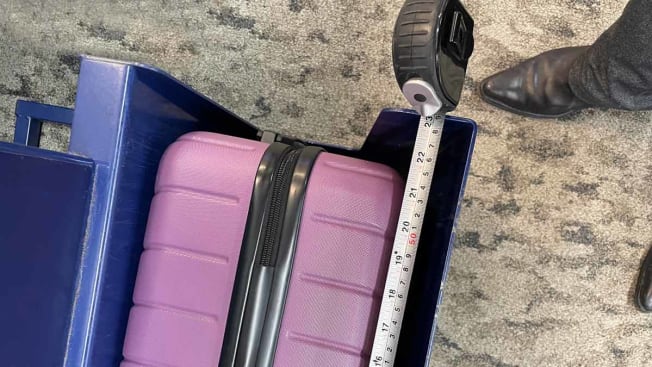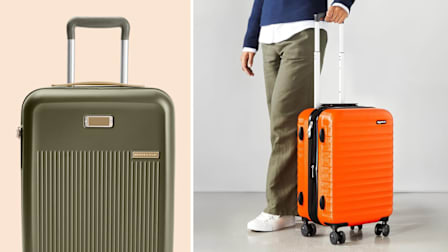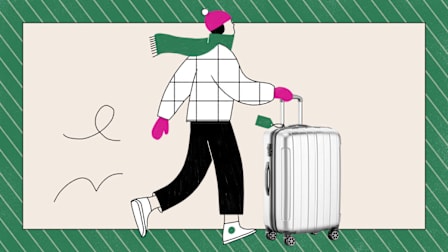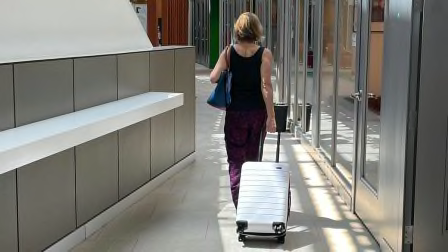Carry-On Luggage Tactics to Save Money—and Your Sanity
Best ways to get your suitcase on board without a fee
When you shop through retailer links on our site, we may earn affiliate commissions. 100% of the fees we collect are used to support our nonprofit mission. Learn more.

I fly often from New York to California and Ohio, and I’ll admit that over the years I’ve used some over-the-top tactics to dodge a checked-bag fee.
I fly with a small, hard-shell carry-on that fits most airlines’ size and weight limits. Then, for my free "personal item," I stuff my tote and laptop bag in a large fabric grocery sack. On occasion, I’ve sweated on the jetway in both a fleece jacket and down coat. Once, I half-filled a pillowcase with clothes because to the airlines, smallish pillows often don’t count.
You can’t blame travelers like me for our fee-skirting hacks. Airlines have invented a cargo load of fees for once-gratis services like at-the-airport ticket printing and choosing a desirable seat. Even the bag you carry with you is no longer safe: In a nationally representative survey of 2,088 US adults by Consumer Reports earlier this year, 30 percent of Americans who traveled by plane in the prior 12 months said they paid a fee for a carry-on bag.
Small, budget carriers in particular benefit from these fees: Fifty-eight percent of Frontier Airlines’ passenger revenue, for instance, comes from “ancillary revenue”—mostly fees, its most recent annual report says. “Budget airlines make most of their profit through add-ons like luggage fees,” says Tim White, CEO and founder of MilePro, a travel website.
Getting your carry-on aboard, fee or no fee, has its challenges—from making sure it meets the size requirements to avoiding a gate size-and-weight check to managing to keep it with you when the flight is full. Here are tips from frequent fliers on navigating the baggage-boarding-and-fee minefield.
With Major Airlines, Follow Size Rules to Avoid Fees
On the nation’s biggest airlines, you can avoid checked-bag fees and the luggage carousel when you use a carry-on suitcase conforming to specific size and weight rules. American, Delta, and United subscribe to common carry-on limits for domestic flights: 22 inches high x 14 inches wide x 9 inches deep, with a weight of less than 40 pounds when packed.
With Small Airlines, Expect a Fee—and Bag Policing
Small, budget carriers may be slightly more generous than the majors when it comes to the size of carry-on bags. Spirit allows for bags up to 22x18x10 inches. Frontier allows bags that are 24x16x10 inches. Allegiant’s limit is 22x16x10 inches. The JetBlue sizer at Westchester County Airport, near CR’s headquarters, indicated that bags needed to be 22x14x9 inches, but the interior we measured was a roomier 23x15x10. (Like United, JetBlue doesn’t allow carry-ons at all for its lowest-tier fare.)
But you’ll nearly always pay for that carry-on. Frontier and Spirit, for instance, charge a minimum of $30 and $35, respectively, for carry-ons when you pay for the ticket and bag at the same time but require an eye-popping $99 if you wait to pay at the gate. Allegiant Air charges $10 to $75 for a carry-on.
And small airlines are much more strict in policing carry-on size and weight—and making you pay if you’re out of bounds, experts say. “Generally, the less you pay, the more strict they will be,” said frequent traveler Mattis Oppermann, co-founder of Carl Friedrik, a luggage brand.
“It’s going to be the discount carriers who are going to bust you,” echoed Clint Henderson, managing editor of news at The Points Guy, a travel website. “If you can successfully get your [oversized] carry-on on board, my hat’s off to you.”
Save on Fees With These Airline Offerings
How, then, can you save on carry-on fees with both the majors and the small airlines? And what can you do to mitigate fees when you can’t entirely avoid them? Here are some suggestions:
• Join the airlines’ loyalty programs. The majors and the budget airlines all have them. They’re free, and if you accumulate enough points or miles, you may earn free perks like no checked- or carry-on baggage fees.
• If you travel a lot with an airline, get its co-branded credit card. Certain cards waive bag fees and offer priority boarding; you’ll also earn frequent-flier miles.
The Delta SkyMiles American Express Gold Card, for instance, is free for the first year and $99 annually thereafter. I once racked up more than $10,000 in charges in a given year and earned a $100 flight credit. Just be sure to pay your balances in full each month to avoid hefty interest charges.
• Prepay small airlines’ carry-on fees. Some budget airlines won’t tell you in advance what you’ll pay for a carry-on; you’ll only find out when you choose an itinerary. But paying for your carry-on when you first book will cost you less than if you wait until later.
Travelers paying for mid-March tickets from Charlotte to Chicago on the Spirit Airlines website, for instance, would pay $35 for carry-on bags. If they waited until they got to the gate, that same carry-on would cost $99 to bring on board. Note, too, that prepaying on the smaller airlines to check bags can actually cost less than prepaying for a carry-on.
• Choose Southwest if you have a choice—and a lot of bags. Though its baseline fare was somewhat higher than competitors’, flying Southwest ended up costing me less when I took my daughter—and several big suitcases—to college her freshman year.
In CR’s survey, around 4 in 10 Americans who had traveled by plane in the prior year said they had chosen a more expensive airline (29 percent) and/or paid for a more expensive ticket (15 percent) to avoid baggage fees.
Extra tip: Among the most annoying non-bag fees is having to pay to select a seat next to a young child. If you’re traveling with kids and have a choice of airlines, check the Department of Transportation’s Airline Family Seating Dashboard to see which ones charge for choosing seating next to a child of 13 or under. (The DOT is proposing legislation, which Consumer Reports supports, that would require airlines to let families with kids book their seats fee-free.)
To Get Your Carry-On Aboard Fee-Free, Consider These Hacks
Keep in mind that luggage marketed as “carry-on size” can be bigger than those standard dimensions. For instance, among the 10 hard-shell carry-on suitcases in our ratings, the top-rated Samsonite Outline Pro Carry-on Spinner is 23 inches high (including the wheels and collapsed handle), 15 inches wide, and 10 inches deep. The American Tourister Wavebreaker 20" Spinner is actually 23 x 18 x 11 inches.
Travelers and travel experts told us that the major airlines are generally less likely to police bags at the gate for size and weight, and make you check them for a fee. “You could get a rogue agent that’s checking more strictly, but generally you’re not seeing that domestically,” says Henderson from The Points Guy.
Still, these measures could help you and your carry-on pass muster:
• Take advantage of the ”squish” factor. “You’re more likely to sneak in a larger bag if it’s not hard-sided,” Henderson notes.
• Use a travel backpack. “They’re less likely to make you put them in the sizer or check them because they’re not ‘suitcase’ suitcases,” Henderson says.
• Make a smooth entrance. Don’t expand your carry-on, and keep outside pockets of soft-sided luggage empty. “If your luggage is an inch or two bigger than it’s supposed to be, don’t go stuffing it until it bulges, too,” says Kimberley DeLauro, Founder of Ready Aim Travel, a travel-related shopping site. Even with bags that conform to regulation size, try carrying extra items in pocketed clothing—like a fishing vest, if you dare.
• Volunteer to check your bag. In the event flight attendants determine that the overhead bins are full, they’ll check your carry-on for free, without measuring or weighing it. I’ve seen them first ask for volunteers, and then offer early boarding in return. If your goal is avoiding a fee on a bag of borderline size, raise your hand for this.
When a Flight Is Full, Try This to Keep Your Carry-On With You
Fees may not always be your focus; keeping your carry-on with you may be the bigger concern. But the later you board and the more crowded your flight is, the more likely you’ll have to check your bag at the gate—even if it fits the airline’s size and weight standard for carry-ons. You won’t pay a fee in that case, but you may end up cooling your heels at the luggage carousel.
One tactic: Board as early as possible. Holders of lower-tier fares can only board early in special circumstances, such as having a disability or traveling with a disabled person, child, or service animal. If you’re none of these, being first in your boarding group can increase your chances of keeping your bag with you.
If you’re able to get your suitcase aboard, stow it overhead ASAP. Stash it feet first and on its side like a library book, in the nearest open overhead bin space in your section. Don’t wait until you get to your seat where there may be no room, advises Mariah Arianna, a world traveler and destination wedding photographer. “If I struggle to find a spot, the staff will notice, intervene, and probably check the bag,” she says.
Above all, be polite and upbeat when dealing with airline personnel. “Just know that a smile and friendly attitude go a long way with airline staff, and can help them overlook your luggage,” DeLauro says.
Regulation-Size Carry-Ons From CR's Tests
With one exception, these bags from Consumer Reports’ hard-shell carry-on spinner luggage ratings are within the common carry-on dimensions of 22x14x9 inches that most U.S. airlines prescribe for domestic travel.
































